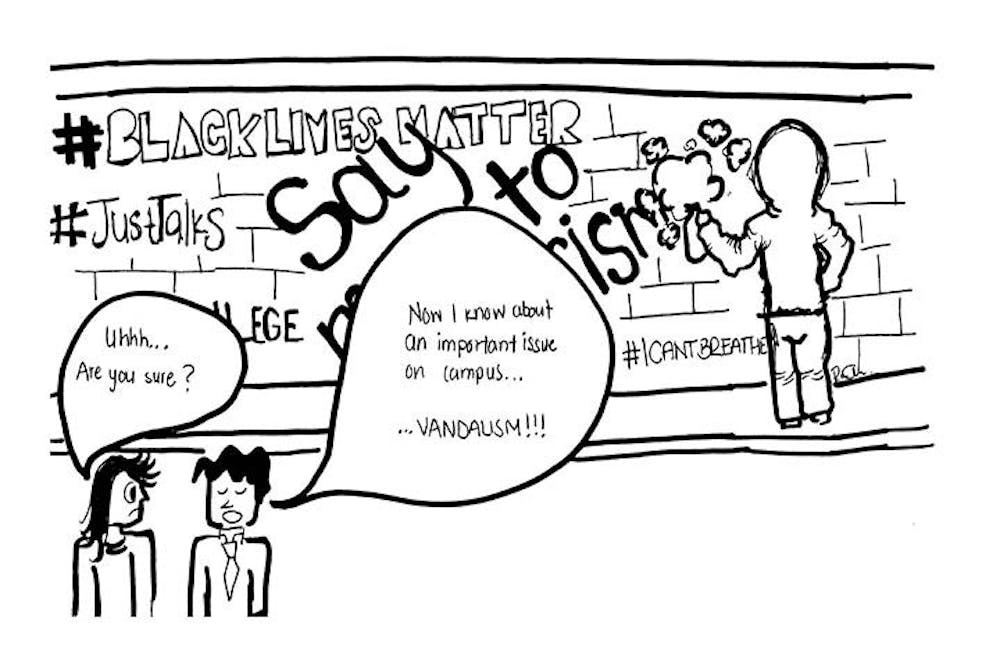Recently, a series of incidents of vandalism brought unrest to the College community. Messages such as “Black Power Matters” and “If you win the rat race, you’re still a rat” have appeared, spray-painted or etched, on the walls of Ross Dining Hall, Warner Hall and McCardell Bicentennial Hall. Many students and faculty feel that these messages are violations of College property and infringements on community trust and accountability.
Having said this, the Campus believes that incredibly important activist messages underlie these incidences of vandalism. By marking College buildings, the activists are throwing the cold hard fact of racism right in our faces. On this predominantly white campus, many students are rarely forced to address issues of race and police brutality. This is not a luxury afforded to people of color, who have no choice but to deal with these issues in their daily lives. Thus, the medium of the artwork is integral to the content of the messages. The graffiti forces us to confront these national issues head-on and makes these often distant struggles highly personal. The vandalism undeniably starts a conversation, and we at the Campus recognize that the conversation it aims to start - about racism and privilege – is vitally important. We question, however whether this is the conversation the activists have actually created.
While the intrusiveness of graffiti definitely contributes to the message, it also has started a polarizing conversation, which has been primarily about vandalism, not race or privilege. Recently, Midd Unmasked was able to contribute to the sexual assault dialogue on campus through posters around campus and an accompanying video in which survivors share their experiences navigating the College’s sexual assault policies. This has been a very productive forum for open dialogue about a critical issue. Importantly, the video made waves without creating an unhelpful side conversation about the destruction of school property.
The limitation of such forums, however, is that they only reach people who actively choose to involve themselves in the conversation. While learning from graffiti may be more difficult than from a forum dedicated to education on the topic, we can still learn a lot from these spray-painted messages. We are witnessing first-hand the effects of confronting our student body with issues it might typically only think about in a classroom setting. The graffiti shows us the urgency and gravity of the issues that affect members of our community every day. It would be easy to write the graffiti off as nothing more than an incident of vandalism, but it is a result of much deeper societal problems that we need to wrestle with as a community.
That being said, an inexcusable side effect of the graffiti is that it has created additional work for our facilities staff members. We are an incredibly privileged academic community, but must recognize the many hours our staff members spent cleaning and repainting vandalized areas. The intention of the vandalism may be to start an important conversation, but ultimately it was disrespectful to staff members. While it may not have been the artists’ intention to create more work for our staff, that has been the unfortunate consequence.
For this reason, we feel that the activists writing these messages should find a less destructive (though hopefully equally effective) means of communicating their message. Even chalk graffiti or a spray-painted sheet would be easier to clean up and less damaging than spray painting buildings. These means of spreading the message would also avoid distractions from the subject matter; we could talk about the messages themselves instead of the vandalism.
We as a community might also want to consider creating a communal space that students could use in any artistic way they like and voice their opinions. Tufts has a statue of a cannon that community members can draw on, paint or otherwise use to express themselves. Perhaps Middlebury needs a similar free-form space solely for this purpose. Currently, we have two chalk walls in BiHall and the mail center, but these spaces are primarily used for advertising and students have not historically taken ownership of these spaces for communicating activist messages. We recognize that these spaces also feel sanitized, and cannot facilitated as strong an effect had the activists placed it there. We need a student-owned space where we can start authentic and meaningful campus-wide discussions.
While we agree with the importance of the issues addressed in the graffiti, we call on artists and activists to be mindful not to let their work come at the expense of other people’s time and hard work. Ultimately, a less destructive means of communicating the same ideas may steer the conversation away from the methods and more toward the subject matter. Furthermore, being at such an institution of higher learning, Middlebury students are well-equipped to initiate conversation in a more sophisticated fashion. While the Campus recognizes and appreciates the message the artists are trying to convey, we urge our peers to communicate the message in a way that better serves our community.


